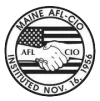Union Representing Screen Actors Affiliates with Maine AFL-CIO

SAG-AFTRA’s New England Local — a union representing 3700 members working in television, radio, digital media and film in New England — has just affiliated with the Maine AFL-CIO. The national union represents approximately 160,000 actors, announcers, broadcast journalists, dancers, DJs, news writers, news editors, program hosts, puppeteers, recording artists, singers, stunt performers, voiceover artists and other media professionals. In Maine the union also represents news broadcasters at WGME Channel 13 in Portland.
“We represent anyone who works in front of a camera or microphone,” explained Benjamin Winthrop Shallop, Business Representative for SAG-AFTRA New England Local.
Shallop said SAG-AFTRA has members from Maine who often work in Massachusetts and Rhode Island where the majority of TV and movie productions in New England are filmed. New England’s filmmaking and acting community is growing as the region experiences a surge of film productions. Shallop says it made sense to affiliate with the Maine AFL-CIO because Portland has become a regional creative hub and a lot of members already live there. SAG-AFTRA is also interested in securing union contracts for political ads as record sums of money have been spent on campaigns in recent election cycles in Maine.
Shallop pointed out that it’s easy to miss the connection between people who worked on films like CODA, which just brought home an Oscar for ‘Best Picture,’ and performers who work in commercials, yet there were 360 people, primarily union members, who worked on the film that was shot in Gloucester, Mass.
“That’s 360 people who need to find work in between those movie jobs and often times they’re working in commercials,” said Shallop. “For working artists, commercials are their bread and butter, so getting those commercials covered under a union contract sustains working artists in our area.”
SAG-AFTRA generally has two types of contracts. At its broadcast shops like WGME, members only have to bargain with one company. But most SAG-AFTRA members are freelance/gig workers who bargain with coalitions of companies. Their leverage depends on all of the members agreeing to only work under a union contract. For commercials, the union bargains with the Joint Policy Committee (JPC), an organization representing advertisers and advertising agencies. For film and television SAF-AFTRA bargains with the Alliance of Motion Picture and Television Producers (AMPTP).
“Mostly what we’re facing in the industry when we’re bargaining now is making sure that we maintain pay equity in such a rapidly changing media market,” said Shallop. “Most TV viewers are getting off TV and going to streaming services. That’s a huge financial impact on our members, both in commercials and in television and theatrical programs. So we need to bargain with them over those types of changes.”
The issue of streaming service profits was a major issue when the New England Studio Mechanics (IATSE Local 481) nearly went on strike last fall as part of a larger, national IATSE contract negotiation.
SAG-AFTRA contracts have different levels including low-budget commercials for social media, regular television commercials with a use payment for streaming services and regional ads that allow members to compete with non-union performers. The union even has a “Influencer Agreement” for TikTok and Instagram influencers partnering with ad companies on branded content. SAG-AFTRA’s Commercial Contracts generate nearly a billion dollars a year for performers. This enables commercial clients to make contributions to pension and health plans directly and allows earning to count toward qualification for member benefits.
“One of the biggest problems we struggle with is that people don’t think our members work real jobs, but we’re in one of the most profitable industries in the country,” said Shallop. “People are making billions off of our membership. It’s a job like anything else.”
